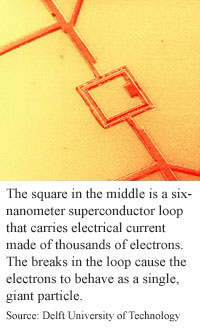
Oversize oddity could yield quantum computers
By Eric Smalley, Technology Research NewsAs it turns out, quantum effects don't have to be confined to the world of atoms and subatomic particles. Research efforts have shown quantum effects in electrical currents of thousands to millions of electrons, a result that raises hopes for building quantum computers that can solve problems that are impossibly difficult for ordinary computers.
Researchers at Delft University of Technology in the Netherlands are one of two teams to produce a superposition in a superconducting quantum interference device (SQUID). Superposition is the quantum mechanical effect in which an atom or particle is in two different states simultaneously.
SQUIDs are tiny loops of superconductor that, when exposed to a magnetic field, carry an electrical current. Superposition in this case is a single set of electrons flowing in both directions at the same time.
"In our system the current can run both ways at the same time, so it has the potential to act as a qubit," said Casper van der Wal, a graduate student at Delft University of Technology. A qubit, or quantum bit, has two distinct states that can represent the ones and zeros of binary computing.
In the quantum state, the current flow of a SQUID has a certain probability of being in one of the two directions. A quantum computer would act on a set of SQUIDs by influencing their probabilities (posing the problem) so that when the SQUIDs leave their quantum state the resulting flow directions would represent a specific number (getting the result).
Researchers at the State University of New York at Stony Brook have created a superposition of a larger current flow in a SQUID. The current flow in the SUNY Stony Brook SQUID contains billions of electrons while the current flow in the Delft device contains millions of electrons.
"Our system is better in terms of testing the limits of quantum mechanics on the macroscopic scale," said Jonathan R. Friedman, a postdoctoral researcher in the department of physics and astronomy at SUNY Stony Brook. "The Delft device may have some advantages in terms of usefulness for quantum computation."
The advantage lies in the number of breaks in the SQUID's superconducting loop. The breaks, called Josephson junctions, cause the flow of electrons to behave as a single, giant particle. The SUNY Stony Brook device uses a single junction and the Delft device uses three.
"Using three junctions allows for making the loop much smaller than a one-junction loop. Thereby the system can be better isolated from noise," said van der Wal. Quantum states are easily destroyed by influences from their environments, so quantum computers' quantum components will need to be well insulated.
Also, quantum computers' qubits will need to be linked. The qubits in SQUIDs-based quantum computers would most likely be linked by inductive coupling.
"Controlled inductive coupling means that the magnetic field produced by one loop can be picked up by a neighboring loop such that the behavior of the two depends on each other," said van der Wal. "We can engineer the strength of this coupling and probably make it even tunable. This is the main advantage of our system with respect to microscopic systems like atoms. Our microfabricated system allows for much more engineering of the system's parameters. The parameters of atoms are set by nature."
Though quantum computers are probably decades away, enough progress has been made that most research efforts are now focused on making practical devices.
"The big advantage about SQUIDs is that they can be fabricated en masse on a chip. Large-scale integration is quite conceivable," said Friedman.
The Delft team has produced chips containing many loops. However, just putting a bunch of loops on a chip falls far short of producing a working quantum computer.
"We [first have to prove] that we can push the control over individual systems to much higher precision than what we could do in our last experiment," said van der Wal. "On the way there we could run into fundamental physical phenomena that [show quantum computing] will never work at all with our loops."
It will likely be 20 to 30 years before SQUIDs-based quantum computers could be commercially available, said van der Wal. "It is like the path from experimental Nuclear Magnetic Resonance machines... in 1946 to MRI machines in hospitals [in] 1982," he said.
Van der Wal's colleagues were A. C. J. ter Haar, F. K. Wilhelm, R. N. Schouten, C. J. P. M. Harmans and Johan E. Mooij of Delft University of Technology, and Terry P. Orlando and Seth Lloyd of the Massachusetts Institute of Technology. They published their work in the October 27, 2000 issue of the journal Science.
The research was funded by the Dutch Foundation for Fundamental Research on Matter, the European Union Training and Mobility for Researchers Research Network on Superconducting Nanocircuits, and the U.S. Army Research Office.
Timeline: 20-30 years
Funding: Government
TRN Categories: Quantum Computing
Story Type: News
Related Elements: Photo; Technical paper "Quantum Superposition of Macroscopic Persistent-Current States" in Science Oct. 27, 2000
Advertisements:
November 15, 2000
Page One
Biometrics takes a seat
Oversize oddity could yield quantum computers
Switch narrows molecular-macroscopic gap
Tiny metal wires chart nanoelectronics
Chip techniques block power leakage

News:
Research News Roundup
Research Watch blog
Features:
View from the High Ground Q&A
How It Works
RSS Feeds:
News
Ad links:
Buy an ad link
| Advertisements:
|
 |
Ad links: Clear History
Buy an ad link
|
TRN
Newswire and Headline Feeds for Web sites
|
© Copyright Technology Research News, LLC 2000-2006. All rights reserved.